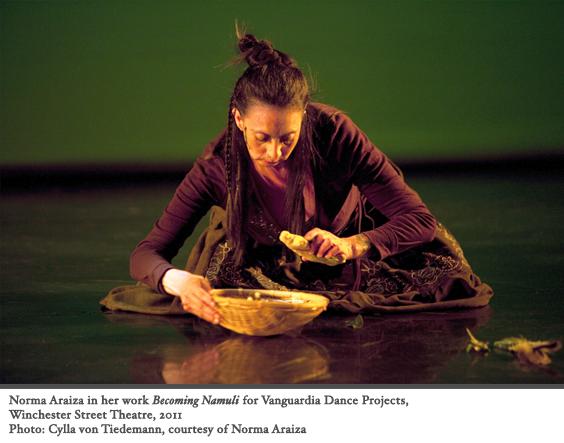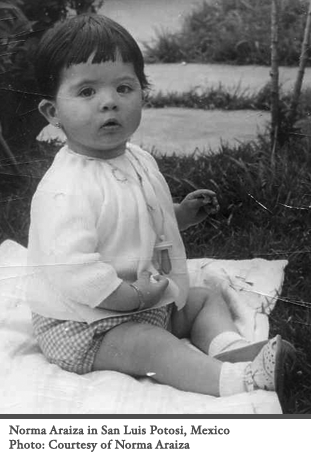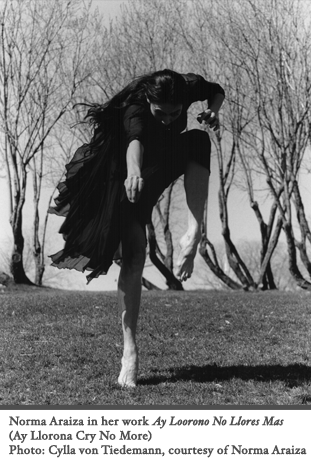| 
next page l enter dancing home Norma Araiza is a Mexican performer, choreographer and instructor from an indigenous background of the Yoeme (Yaqui) Nation from Sonora, Mexico. She has studied different disciplines within the arts in order to find her own unique style. This style blends dance, theatre, vocals, percussion and Tai Chi Chuan, and uses cultural and traditional themes – especially from her indigenous past. Araiza has studied widely, including training with international theatre directors Jerzy Grotowski and Eugenio Barba; butoh master Natsu Nakajima; theatre groups Tascabile di Bergamo, Pippo Delbono Company – both from Italy – and Kei Takei from New York.She has performed extensively as a professional actor and dancer in Mexico, Hungary and Colombia as well as California, Ontario and Montreal. She founded Creando Huecos Company in 1986 and co-founded Tolmec Dance Theatre in 1988 in Mexico City. While in Mexico, she was an assistant director, choreographer, dance theatre performer and researcher at the National University of Mexico in the Laboratory of Performing Arts. At present Araiza is artistic director of Tolmec Dance Theatre, an independent Toronto-based group working primarily with culturally specific themes through the medium of dance theatre. She is also a member of various collectives working in and promoting dance theatre events, Latin American artists and cultural events. She is also greatly involved in community arts. She completed her Master's in Dance at York University where she taught for several years, and is a graduate of the Expressive Arts Therapy Program at ISIS-Canada. Araiza is currently working at Hospice Toronto as a facilitator and head of the Expressive Arts Therapy Program. She is a member of CADA, Dance Ontario and Dancer Transition Resource Centre; she has also served on the Dance Committee of the Toronto Arts Council, and as a jury member of the Ontario Arts Council. Araiza has also collaborated on theatre projects with Canadian Stage/Hour Company, L&L Productions, Inner Stage Theatre, Modern Times Theatre Productions and Leading Tone Arts Productions, among others, as a choreographer, actors' coach and performer. Araiza has been a recipient of various grants from the Ontario Arts Council, the Ministry of Culture through the Ontario Quebec Cultural Exchange, the Toronto Arts Council and the Laidlaw Foundation. Carol Anderson spoke with Norma Araiza at her home in Toronto on August 20, 2013.


Carol Anderson: Norma, I would like to plunge in and ask about your story of coming to Canada – when did that happen – why did it happen, and how?Norma Araiza: I did not intend to stay in Canada. I arrived in August 1989, at the invitation of a very good friend from Mexico who had recently immigrated to Toronto. I was struggling a lot because the university program I was working in at the National University of Mexico suddenly closed. It was shocking. I suddenly didn't have a job – and this coincided with breaking up with my partner at that time. So I felt really lost. My friend said, “Why don't you come to Toronto to visit and stay for a couple of months to think about what you want to do?” That was it. He sent me the ticket, and I came, I loved it and I never went back. CA: From what part of Mexico did you emigrate? NA: I grew up in Mexico City. My mom is from the Yoeme Nation of Sonora, which is north, and my dad was Mexican, from the centre of the country – San Luis Potosi. Very soon after coming to Toronto, I called my parents and said, “Well, guess what, I'm going to stay.” Things developed really quickly. I met someone a few months after arriving; I got married a year later, and that's it! It was quite fast. NA: I grew up in Mexico City. My mom is from the Yoeme Nation of Sonora, which is north, and my dad was Mexican, from the centre of the country – San Luis Potosi. Very soon after coming to Toronto, I called my parents and said, “Well, guess what, I'm going to stay.” Things developed really quickly. I met someone a few months after arriving; I got married a year later, and that's it! It was quite fast.
I had some knowledge of dance in Toronto because one year before I left there was an international contemporary dance event in Mexico City. Denise Fujiwara's group T.I.D.E. [Toronto Independent Dance Enterprise] was there. I met them and loved their work. At that time I spoke virtually no English, but we managed to understand each other. When I came to Toronto the first person I looked up was Denise – and then Darcey [Callison]. That's how I started getting into dance here. Denise gave me a couple of names of people I could take class with. At first, my intention was to stay for three or four months. Then I extended my visa – and altogether extended it four times. Finally the immigration person said, “Okay, either you apply for your residency, or you get the hell out of here!” I was already involved with my now ex-husband and he said, “No I don't want you to leave.” So one of the reasons we got married was immigration … but we were in love, and we stayed together for ten years. We have a daughter, and we're still wonderful friends … but that's another story. CA: Some people I've spoken with have had quite a journey to get here, and once here, to find stability and get status as citizens. But it wasn't too difficult for you …?NA: No – I was very lucky. I feel very grateful to Canada, to my ex-husband, to life in general at that time, after that struggle in Mexico. I didn't have trouble. I got my papers after one year, and after three years I became a Canadian citizen. A Mexican friend who was doing her BA at York, who I met in Toronto, actually, said, “You're a dancer, why don't you continue your studies?” In Mexico at that time we didn't have a formal school of dance. Now, we do, but before I left, we didn't. So the concept of going to school to do dance was totally foreign to me. I was really excited. I already had a BA in social psychology, and I didn't want to do another BA. I inquired about Master's degrees, and did my MA at York. That's where everything started. CA: Just to backtrack a little … your first language is Spanish?NA: Yes. CA: And you had no English, arriving in Toronto … NA: I lived in Europe for two years – but never wanted to speak English. It was mostly my own funny political position, in terms of thinking, “I don't want to speak the language of imperialism, of the US.…” So I learned French, Italian and Polish, because I lived in Poland for a year. But I learned only a few English words. I could sing Beatles songs perfectly, but had no idea what I was saying – that kind of thing. When I came to Canada my ex-husband was instrumental in helping me with applying to York, and with my everyday language practice. I went to English school for only three months. I love languages and learned very quickly. Having an English-speaking boyfriend – well, it was very funny, you can imagine all the misunderstandings – but I learned really quickly. And years later, I became an ESL teacher. CA: So while you were studying at York, English was new for you. NA: Oh yes! CA: Tell me about your research. CA: Tell me about your research.
NA: First of all I had to do the English test at York – if you're a foreign student you have to take this test to establish your level of literacy. I understood a lot, but I couldn't speak very well. So I did very poorly. The university suggested I do a couple of undergraduate courses to get better acquainted with the language, and that's what I did. Dance history – pre-twentieth century – with Norma Sue [Fisher-Stitt] and it was fantastic. I learned so much. I studied Labanotation and one other academic course. This study really helped me – not only with the English language, but it put me into a context of Western dance, and what I was going to be immersed in. It was a very important thing to do – I thank the person who suggested that. CA: When you were doing your own research, what was your investigation? NA: I investigated the forty days of Lent in the Yaqui Nation. There's a lot of dance involved. As I said, my mom's indigenous – that part of my heritage calls me. So when I was at York, I decided to go back to Sonora and research the dances of the Yaqui people. It was another gift from life. Because I was a foreigner, even though I was part Yaqui and also Mexican, at first it was hard to find a way in.CA: You have no immediate relatives there?NA: No, not any more. Everybody went to different parts of Mexico, so I don't have family in Sonora at all. My mum was the last one born in Sonora. There is a very important dance in the Yaqui Nation, the Deer Dance, which offers cultural insight about the Yaqui people. It was essential for me to research this specific dance, and then the dance of the Matachines and the dance of the Pascolas. There is a whole theatrical event – it's not performance, but a representation – of the forty days of Jesus Christ's journey from Ash Wednesday to Easter. I was able to stay in Sonora for the whole thing. I was lucky that a family adopted me there; through them I learned so much about the dances. They were very involved in the community, and they actually organized a ceremony for me to be accepted as a Yaqui woman in the Nation. It was incredible. They introduced me to different people I could talk to and interview. I learned a lot of the dances. I did a recounting, like storytelling, of the whole event as an anthropological study. I was very interested in the anthropology of theatre that Jerzy Grotowski and Eugenio Barba developed. So I went to Sonora wanting to do my research with that focus – dance anthropology. That's what the program at York was called before ethnography. It was perfect for me. So that was my thesis. (next page) | |




 NA: I grew up in Mexico City. My mom is from the Yoeme Nation of Sonora, which is north, and my dad was Mexican, from the centre of the country – San Luis Potosi. Very soon after coming to Toronto, I called my parents and said, “Well, guess what, I'm going to stay.” Things developed really quickly. I met someone a
NA: I grew up in Mexico City. My mom is from the Yoeme Nation of Sonora, which is north, and my dad was Mexican, from the centre of the country – San Luis Potosi. Very soon after coming to Toronto, I called my parents and said, “Well, guess what, I'm going to stay.” Things developed really quickly. I met someone a 